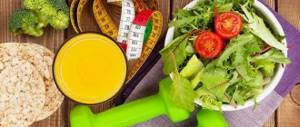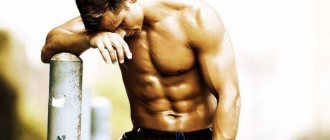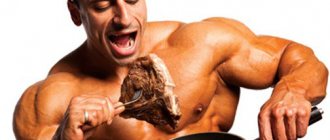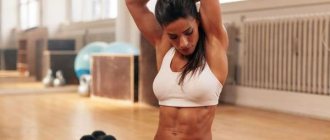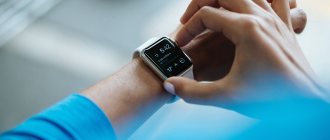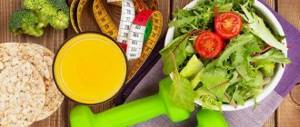Can you eat bananas before and after training?
Anyone who at least somehow monitors their diet and tries to diversify and enrich their diet as much as possible knows: banana is not an ordinary fruit, but at the same time a very healthy one.
Not everyone likes these fruits, but for those who prefer to actively train and eat healthy, they simply need to consider including this fruit in their menu. Bananas after a workout are a great way to replenish expended energy; Bananas before training are a good option to give your body a quick boost of energy. However, to achieve the best results from sports, you need to know a number of important rules about how, when and in what quantities it is best to eat these exotic fruits. As with any other product, it is important to find a “golden mean” with a banana - due to its high calorie content, this fruit is not advisable to eat in large quantities, and due to its high content of vitamins and minerals, it is also impossible to completely abandon it.
In a cocktail
In bodybuilding, bananas often become a component of cocktails. They improve the taste of the milk drink, making it more valuable and healthy.
To gain muscle mass you can use the following products:
- Milk;
- Chocolate;
- Cottage cheese – maybe fatty;
- Oatmeal;
- Eggs;
- Cocoa;
- Nuts.
To dry bananas you can add:
- Berries;
- Low fat milk;
- Skim cheese;
- Any fruit with low (less than 80) calories.
The rest is only about your imagination. There are hundreds of milkshake recipes online, but the most interesting taste comes when you try to create it yourself.
For example, a combination of milk, banana and cottage cheese is great for gaining lean muscle mass. All this can be seasoned with 5 grams of cocoa.
After training, you can add chocolate to milk, banana and cottage cheese.
During the period of mass gain, we add a source of carbohydrates in the form of oatmeal. It is acceptable to throw raw oatmeal into a blender. Nuts are an excellent source of great plant-based fats and proteins.
Have you figured out how to use bananas in bodybuilding? Like and share the material with your friends if you liked the post.
If you have any questions, write them in the comments. We will help solve any problem!
Share link:
- Click to share on Twitter (Opens in new window)
- Click here to share content on Facebook. (Opens in a new window)
Can you eat bananas after a workout?
Bananas are fast carbohydrates, however, they contain quite a lot of fiber and vitamins.
As you know, fast carbohydrates are absorbed in a fairly short time and give the effect of instant saturation. Unfortunately, this effect disappears quite quickly (after 20-30 minutes you want to eat again), but most experienced trainers say that the diet of any athlete should contain both slow and fast carbohydrates.
Can you eat bananas after a workout? If you answer this question briefly, then yes, you can. And even necessary. And there are more than enough reasons for this:
- Immediately after training, the body urgently needs to replenish the expended energy. Often, it is not possible to take a full, healthy dinner with you to the gym, and the journey home from the gym takes a lot of time - in this case, you can delay the post-workout meal, which will inevitably lead to depletion of muscle tissue (the body will take nutrients first specifically from muscles). That’s why a banana after a workout is a great way to partially replenish expended energy and quickly increase blood sugar levels, thereby starting the process of energy production and, accordingly, muscle growth.
- 100 g of banana contains on average 20 g of carbohydrates and 1.7 g of protein - about 90 calories. In general, it is recommended to eat 1-2 bananas within 20 minutes after training - this will help quickly satisfy your hunger.
- Due to the high content of dietary fiber (fiber), bananas help normalize the functioning of the gastrointestinal tract and eliminate the possibility of constipation. The content of a large amount of vitamins, minerals and nutrients gives the body everything it needs for the coordinated functioning of its organs and systems after heavy physical activity.
Depending on the type of workout, post-workout bananas should be consumed in different ways:
- For those who set the main goal of sports training to gain weight , 2 medium-sized bananas as a snack 10-20 minutes after exercise will be very helpful. Then, within 30-60 minutes you need to eat well (a complete “sports” lunch/dinner - meat, boiled vegetables / porridge, chicken breast, fresh vegetables and herbs / baked fish, potatoes / protein shake / gainer, etc. - only 300-400 calories).
- For those who go to the gym to get rid of extra pounds , 1 small banana immediately after class will be enough, plus a protein shake or a light protein lunch/dinner (boiled chicken breast with vegetables/cottage cheese with honey/whole grain bread sandwich with soft cheese and greens - only 200-300 calories).
- For those who are undergoing a drying procedure , immediately after training it is allowed to eat one small banana (if the feeling of hunger is strong enough). It is important to remember that any excess calories will not go away - they will invariably be deposited in the form of subcutaneous fat, so during cutting it is important to strictly follow the temporarily developed menu - more proteins, less carbohydrates, minimum fat. If it is possible to reduce the amount of fast carbohydrates as much as possible after a workout, it is better to do this and eat a banana 20-30 minutes before the start of the workout.
It is important to remember that even in the case of training to gain weight, extra calories will not bring any benefit to the athlete, so eating a kilogram of bananas is absolutely pointless and even harmful - you still won’t be satiated for a long time, unprocessed carbohydrates are invariably deposited as fat in the most problematic areas, Excess blood sugar makes it difficult for the heart to work.
Is it possible to eat bananas at night?
Due to the high calorie content of bananas, many people are hesitant to eat them in the evening after a workout or before bed. Whether this is right or wrong is difficult to give a definite answer to this question: it all depends on each specific situation:
- For those who train for weight late in the evening and go to bed 2-3 hours after training, eating 2 bananas is the norm. Fruits will help satisfy your hunger and replenish some of the energy expended. Don’t be afraid that carbohydrates will “turn into fat” - after an intense workout, the muscles are “hungry”, so they will take the bulk of the nutrients.
- For those who want to lose extra pounds, you can eat 1 banana after a late workout. Further, it is recommended not to get carried away with fast carbohydrates, but to focus your diet on protein foods, adding a small amount of slow carbohydrates.
If you trained during the day, and before going to bed you suddenly wanted a snack, then it’s better not to get carried away with bananas - at this time it’s enough to drink a glass of kefir, eat a portion of low-fat cottage cheese, chew a fresh cucumber with a slice of soft cheese or boiled protein.
Is it possible to eat bananas before training?
As for the benefits of eating bananas before training, the opinions of different trainers differ:
- As already mentioned, eating bananas leads to a sharp increase in blood sugar. The body begins to produce insulin, the person feels a surge of strength and vigor. The problem is that this effect is very short-lived - after 20-30 minutes the batteries run out, the athlete feels tired - the body requires a new portion of sugar. If the situation described occurs after training, when the athlete is resting, it is enough to simply “stimulate” the body with a portion of a protein shake or gainer. But if you ate a banana 20-30 minutes before training, then the moment of loss of strength will occur during the main part of the training. In such a situation, it is difficult for an athlete to work at full strength and lift heavy weights, which significantly reduces the effectiveness of training. For additional recharging during sports, you will have to “feed” yourself with fast carbohydrates.
- Another opinion is that eating bananas before training is possible and necessary. Firstly, because they allow you to quickly satisfy your hunger. If you were unable to have lunch (or dinner) before training, it is quite acceptable to “fuel” yourself with 2 bananas. Also, some experts recommend eating bananas before morning workouts.
In addition, there are a number of recommendations for eating bananas regarding the type of workout:
- Bodybuilding, strength training . 1-2 bananas 30-60 minutes before training - and you are energized and full of strength. It’s not bad if, instead of a simple banana, you drink a portion of a fruit-protein shake - it will help you quickly fill up and satisfy your hunger for a long time.
- Fitness, workout for weight loss . In this case, you are allowed to eat 1 banana an hour before class, but you should control the amount of calories consumed and ensure that your diet contains as few fast carbohydrates as possible.
- Drying . For cutting athletes, the main rule is minimal fat consumption and a reduction in the daily menu. Bananas have little fat, but the calorie content per 100 g is about 89 calories. Thus, 1 banana can replace 100 g of boiled veal or beef liver in terms of nutritional value - it will provide much more energy benefits for the body during drying, and not a single gram of fat will enter the body.
Whether or not to eat bananas before training is up to each athlete to decide for himself, based on the desired results and goals. The main thing is to know moderation in everything, to find a “golden mean” - any overeating or undereating before physical activity leads to discomfort and, accordingly, a decrease in the effectiveness of exercise.
Drying
The main rule of fat burning is to spend more than you consume. Bananas in bodybuilding for cutting can only be eaten with an eye on the ability to count calories. We are talking about a fairly high-calorie fruit that can be used in the daily diet, but not in large dosages. It is better to rely on other fruits with a lower glycemic index and calorie content per 100 grams of product.
For example, 100 grams of strawberries look like this:
100 grams of raspberries:
Energy value of 100 grams of carrots:
100 grams of celery:
The difference is significant. This does not mean that bananas are not suitable for drying. But you shouldn’t lean too much on them.
Can you eat bananas while working out?
During training, many athletes (especially those who want to increase muscle mass) give themselves mini-snacks - a portion of a protein shake, a gainer, juice, fruit.
A natural question arises: is it possible to eat bananas directly during training? After all, they are very nutritious, plus they provide a quick surge of energy and strength.
In fact, during a workout, you can eat a small piece of banana (no more than half) - this will slightly increase your blood sugar levels, reduce fatigue and make your workout more effective.
For strength training, which usually lasts no more than 45 minutes, 1/3 of a banana is enough. For those who train for 45 to 60 minutes, you can eat a little more - ½ banana, dividing it into 2 parts (consume at intervals of 20-30 minutes).
Benefits of banana for the body
Bananas are, of course, good for more than just athletes. The body of any person receives enormous benefits from eating these tropical fruits:
- Increased stress resistance, improved mood . Thanks to the content of tryptophan, an amino acid that is converted in the body into the “happiness hormone” serotonin, bananas help fight depression. The vitamins and minerals contained in the fruit ensure healthy sleep and maximum relaxation of muscle tissue (which is undoubtedly especially important for athletes).
- Normalization of heart function . The mineral composition of bananas contains potassium, which is essential for the smooth functioning of the heart. Why eat bananas after a workout? To ensure good levels of blood circulation and reduce blood pressure.
- Beneficial effect on vision . Thanks to vitamin A, which is found in large quantities in bananas, our eyes are protected from negative external influences. In addition, this vitamin helps improve visual acuity.
- Helps digestion . Dietary fiber ensures the smooth functioning of the gastrointestinal tract and helps remove all unnecessary, harmful substances from the body. Thus, a natural cleansing of the body occurs, along with which excess weight loss is observed.
- Improving brain function . Due to the high content of vitamins, bananas contribute to better nutrition of the brain. In addition, a rapid increase in blood sugar levels helps to launch metabolic processes at the level of the central nervous system.
Banana has a high glycemic index - this fruit is very nutritious and high in calories. Also, if you suffer from diabetes, then, despite all the beneficial properties of this fruit, you should avoid eating it.
Benefits and harms
Well, we found out whether you can eat a banana after a workout and came to the conclusion that this idea is quite reasonable.
In conclusion, let's talk about why this is needed:
- The fruit contains the amino acid tryptophan, which is converted into serotonin, the well-known hormone of joy. Thus, the product improves mood and eliminates stress;
- Bananas are rich in potassium, the latter has a beneficial effect on the cardiovascular system;
- Vitamin A protects and restores vision;
- Fiber improves digestion and promotes good metabolism;
- B vitamins perfectly strengthen the nervous system;
- The fruit is a natural antioxidant;
- Iron in the composition increases hemoglobin and improves the quality of blood.
Bananas cannot cause any particular harm, except for their ability to sharply increase blood sugar levels. Therefore, the product is prohibited for people with diabetes. It is also contraindicated in cases of coronary heart disease, blood viscosity, and trombophlebitis.
Remember to wash the peel thoroughly before peeling as it may be treated with chemicals.
Allergy sufferers should eat the fruit with caution.
That's the whole list of its shortcomings, as you can see, there are many more advantages.
So now you know why and when to eat a banana after a workout. Feel free to have healthy snacks after finishing hard work in the gym. Don't be afraid to treat yourself to some sweet fuel.
Source
Bananas before workout
Bananas before training charge you with vigor and good mood.
You should engage in sports not only in a good mood, but also with a charge of vivacity. It is known that you should not eat food immediately before training, but what about a small snack that will not burden your stomach and will provide you with energy? A banana is perfect for this purpose. This sweet tropical fruit is unique in its vitamin and mineral composition. It contains a large amount of sugar and at the same time has a low calorie content - only 90 kcal per 100 g. Bananas can be taken regardless of your workout goal. They are suitable for both weight loss and muscle gain. Let's find out in more detail how useful a banana is before a workout, when and in what quantity to consume it, and in what cases it is better to abstain from it.
Using Bananas in Smoothies and Dishes
Not everyone can constantly use the same product, even if it is incredibly healthy. This is why even such a healthy fruit as a banana can get boring over time. However, if you add them to your food, prepare a banana smoothie for gaining muscle mass, or mix them in a salad, they will not get boring even if you eat them every day. For breakfast, bananas with peanuts for gaining muscle mass are an ideal combination, so they can be seasoned with oatmeal . You can also puree them in a blender and use them as jam for toast. For a thicker consistency, it is better to add cottage cheese. Banana is one of the main components for creating a “natural gainer,” that is, a protein-carbohydrate cocktail. To prepare, mix in a blender:
- 1 banana;
- 150 grams of cottage cheese;
- 100-150 ml low-fat milk;
- 1 tbsp. honey;
- Berries to taste.
If you need to limit calories, then omit the honey and use ripe fruits. They will provide sweetness, but will reduce the amount of carbohydrates in the cocktail. Select cottage cheese and milk depending on what consistency you prefer. https://www.youtube.com/watch?v=C17Y0_kdJvU Bananas are also used in healthy dietary baked goods (protein pancakes, cereal cookies, etc.) in the form of gluten and flavoring. Blend them in a blender, and they are perfect for replacing high-calorie toppings, so they can be used in any desserts.
Vitamin and mineral composition of banana
Bananas have a full range of beneficial vitamins and minerals.
We will not describe the entire biochemical composition of the banana. Let us dwell only on the main components of this fruit and consider their effect on the body. 100 g of ripe fresh banana contains the following elements:
- Potassium (348 mg) – maintains optimal water and acid-base balance. Prevents the occurrence of seizures, has a positive effect on the motility of the heart muscle.
- Magnesium (42 mg) – necessary for proper energy metabolism. It has a positive effect on the vascular system and removes excess cholesterol.
- Phosphorus (50 mg) – strengthens the skeletal system.
- Calcium (13 mg) – is responsible for biochemical intracellular processes, bone strength, blood clotting.
- Iron (1.5 mg) – is a component of hemoglobin and is involved in the oxygen supply of body cells.
- Selenium (1 mg) is an element necessary for the proper metabolism of proteins, fats and carbohydrates. Penetrates muscle tissue and supports their contractile activity.
How and when to take a banana before training
So, we have seen how beneficial bananas are for the body. It remains to be seen when and in what quantity they can be consumed. Let's look at two training options: for gaining muscle mass and for losing weight.
Pre-workout bananas to gain muscle mass
Bananas should be eaten no later than 30 minutes before training.
Carbohydrates before exercise will give you a boost of energy and help maintain optimal levels of glycogen in muscle tissue, which is greatly depleted during grueling exercise. The best option is slow carbohydrates, but if necessary, they can be replaced with tropical fruit. Why is banana best for this? First of all, because of its vitamin and mineral composition, which has a beneficial effect on the muscle, bone and cardiovascular system. Bananas are quickly absorbed by the body and do not leave a feeling of heaviness in the stomach, fast carbohydrates turn into energy and contribute to a more effective workout, and the tryptophan contained in the fruit sets an excellent mood. After training, it is necessary to restore the glycogen supply in the muscles, otherwise there will be no muscle cell growth. And in this case, a banana is an ideal option for a snack.
So, we found out that bananas can and even should be consumed before and after training. If your goal is to build muscle mass, the daily intake of bananas can be 1 – 1.5 kg. They should be eaten no later than 30 minutes before training and 20–30 minutes after training, but no later than 18.00.
Don't expect that eating bananas will help you build ripped muscles. The result is achieved only through long-term training supported by a balanced diet.
Bananas before workout for weight loss
Due to their low calorie content, bananas can be consumed during a diet.
Due to their high carbohydrate content, bananas can hardly be called a dietary product. However, they are low in calories and contain no fat. Bananas are very filling and can be used during weight loss, if you consider them not as an addition to food, but as a complete meal. And so that the taste of bananas does not become boring, you can make a cocktail from them with the addition of skim milk, yogurt or kefir, and mix with cottage cheese.
For weight loss, the most effective exercise is aerobic exercise, which is best done on an empty stomach. When the body's glycogen reserves are low, fat tissue is burned during exercise. If you eat bananas before classes, the body will get rid of the energy received without affecting fat. Therefore, snack on bananas after training and do not overdo it: a couple of bananas per day will be enough.
Don't eat bananas before bed! If the energy received is not consumed, it is stored in reserve in the form of excess weight.
Now you know how beneficial bananas are before and after exercise. Eat right, exercise regularly, and your body will be fine!
How to choose the best variety and ripeness of bananas?
Not all bananas are equally healthy, so the question of choice is quite important. Of course, even the “bad” types of bananas will have the necessary substances and what this fruit is so valued for in sports, but in much smaller quantities.
It is also worth considering that depending on ripeness, their glycemic index will change, therefore, during weight gain and weight loss, it is better to choose fruits with different degrees of ripeness.
First of all, you need to consider the color of the peel. It tells how ripe the banana is. If you see black spots, this is the "final stage" of maturation. Typically, these fruits are the most delicious because they increase the amount of fructose (sugar), but because of this they become more caloric. If you are gaining muscle mass and love sweets, then ripe bananas with blackened skin are the best option. They are the most delicious and will be an excellent addition or even a replacement for delicious desserts.
During the period of drying or losing weight, it is better to take fruits with yellow skin or those that do not yet have brown spots. The presence of green sides is also preferable. The glycemic index of such fruits is 42-48 units, while brown bananas have 55-65 units. Do not neglect green varieties. This is by no means an unripe fruit, but one of the varieties. They are especially good when dried, and they are often preferred for their unusual aroma. If you choose bananas by size, it is better to give preference to small or medium-sized fruits. In many countries, large fruits are considered fodder and are sent to farms to feed livestock. From a nutritional point of view, they are not particularly inferior to “small” varieties, but in terms of taste they are almost always worse.
How are bananas good for athletes?
Surely many of us have seen how professional athletes consume bananas before or between competitions. This yellow fruit is indispensable in the diet of racers, tennis players, football players and other athletes. But why is banana so good and attractive?
Let's look at the composition of this fruit. Is it fruit? According to botany, a banana is a berry. But in cooking it is still considered a fruit. The calorie content of a banana is 95 kcal per 100 grams, but despite this, it is considered a dietary product. The chemical composition is incredibly rich. Banana pulp contains:
Vitamins:
- A - prevents the formation of cancer cells and the development of cardiovascular diseases;
- Group B (B1, B2, B4 (Choline), B6, B9) - fights stress and insomnia, improves the condition of hair, nails and skin;
- E - prolongs the lifespan of cells, improves skin condition;
- C - strengthens the immune system and protects against infections;
- K - improves the functioning of the gastrointestinal tract;
- PP - is an antioxidant, that is, it suppresses oxidation;
- Beta-carotene is also an antioxidant that improves immunity and mental performance.
Micro and macroelements:
In addition to the fact that bananas lift your spirits and relieve stress, their consumption has a beneficial effect on our gastrointestinal tract. Thanks to potassium and magnesium, the condition of bones and muscles, and the heart improves. A beneficial effect on the condition of nails, skin and vision has been proven.
If you play sports, then you need bananas to restore expended energy. They also reduce muscle fatigue and increase endurance of the entire body. And, oddly enough, they help reduce weight. So, to gain muscle mass after training, you should eat cottage cheese, not bananas.
Health benefits: sunny sweet fruit
It has become fashionable to play sports, keep fit, and eat a properly balanced diet. This is very good, because the problem of excess weight, obesity and cellulite has long become widespread. One of the extraordinary fruits that is worth a closer look is the banana, which contains many useful substances.
Many say that these fruits are harmful by default, because they reach store shelves exclusively through a special “gas chamber.” Allegedly because they can only bring harm to the body. However, here it is better to understand thoroughly what we are talking about. Indeed, in order to deliver the fruits intact, they are picked green. After such stress, fruits are no longer able to ripen on their own. Therefore, they are placed in special chambers where they are exposed to ordinary ethylene. It is he who stimulates the processes of converting starch into sugar. Thus, there is and cannot be anything harmful, much less dangerous, in the carbonation of bananas.
Energy value and composition
So, the calorie content of 100 grams of fruit is 88-100 kcal. At the same time, proteins account for only 1.5 grams, fats account for 0.1 grams, and carbohydrates equal 21.7 grams. The lion's share of the latter falls on mono- and disaccharides. So judge whether you need a banana before training, with all its rich chemical composition, and it certainly won’t “let you down.”
There are also quite a lot of vitamins, although some time ago it was fashionable to talk about its “emptiness”.
- First of all, there is a lot of beta-carotene, a precursor of retinol (vitamin A), while being the most powerful of antioxidants.
- The second substance of the same subgroup, also “able” to bind free radicals, is vitamin C - the notorious ascorbic acid.
- They are rich in vitamins from group B: thiamine, folic and pantothenic acid, riboflavin, niacin, pyridoxine.
- The fruits also contain tocopherol, which will be especially interesting for girls, because it is deservedly called a “female” vitamin.
- This tropical fruit also contains rare vitamin K.
Tropical fruits are also rich in other substances, macro- and microelements. They are high in iron for people with anemia. Potassium is useful for the heart muscle and the regulation of water-salt balance, it saves from cramps, neutralizes excess sodium, allowing calcium to be better absorbed and used to “build” bone tissue. Magnesium reduces stress, and fiber has a beneficial effect on the gastrointestinal tract.
Bananas contain the substance ephedrine, which is a mild pain reliever, as well as the unique amino acid tryptophan. Under the influence of the latter, the human body itself begins to produce serotonin, which is commonly called the “happiness hormone” by common people. It can even significantly prolong an erection in men and awaken libido in women. However, to achieve the effects, it is not enough to simply eat a few fruits. You need to methodically, regularly consume several fruits a day to get lasting results.
Can you eat bananas after strength training?
Need to! If you are engaged in strength training and have been asking this question for a long time, then cast aside all doubts and feel free to include bananas in your post-workout diet. During physical exercise, our body loses a huge amount of strength and energy, and so that sport does not turn into exhaustion and exhaustion for us, energy reserves must be replenished. At this moment, a nutritious and healthy fruit comes to our aid. Thanks to fast carbohydrates, muscles receive the necessary supply of glycogen. Glycogen is a complex carbohydrate that represents excess glucose entering the body. After training, the level of glucose in the blood decreases and fatigue appears , this is when glycogen comes into play, which breaks down and provides the necessary amount of glucose to replenish energy in the muscles. Adequate glycogen stores are important not only for muscles, but also for healthy liver function, and therefore eating foods containing large amounts of carbohydrates is a must for athletes. Bananas also replenish potassium, which helps you avoid cramps after grueling workouts. But don’t go overboard with the number of bananas: 2–3 pieces are enough to replenish your reserves of essential nutrients.
Should you eat bananas before training, how much and why?
Certainly! Before any physical exercise you need a good boost of energy, but where will it come from if you train on an empty stomach? As mentioned earlier, the beneficial elements of bananas are very quickly absorbed by the body, and despite their high calorie content, their moderate consumption and constant training will not allow you to gain weight . Eating two bananas before starting physical activity will increase glycogen levels to the desired level, and this, in turn, will help maintain performance throughout the workout. After this, you will not have a stomach ache during training. Activity and productivity increase, and with them the result.
Which banana variety should you choose?
Did you know that bananas come in many varieties? Their variety depends on color, size and taste. But it is unlikely that more than three types of this fruit can be found on the shelves of our supermarkets. However, do not rush to get upset, the most common and best-selling variety is called Cavendish, and it just so happens that it is best suited for use before and after training.
What color should bananas be to prevent abdominal muscles from hurting?
It would seem that the answer to this question is obvious. Almost no one likes green bananas; they are not ripe and sticky. But don’t rush to grab the beautiful and ripe yellow fruits. With almost 100% probability, they were treated with a special gas, which accelerates their ripening, but at the same time takes away a fair amount of nutrients. Therefore, feel free to buy green bananas and let them ripen at your home. The riper the banana, the healthier it is. But not to the point of fanaticism, of course.
In short, a banana is a great snack and a way to recharge. Do not deny yourself the pleasure of eating this fruit before, after and even during training. Now you know why you need to eat bananas before and after training, and also how many pieces you need to eat. A banana will not only improve the condition of your entire body and improve your athletic performance, but will also improve your mood, and training with a good attitude and a smile on your face is always more pleasant and productive.
Muscle gain
Unlike most fruits, bananas are very high in calories, making them great for gaining muscle mass and toning the body. It will not become the basis of the diet, but it can be an excellent addition.
The energy value of 6 average bananas looks like this:
Banana is a fast carbohydrate that is best taken at the right time, rather than during the day. The best option would be to eat a large amount of the fruit before and after training. The rest of the time we rely on slow carbohydrates - cereals.
Bananas are a storehouse of vitamins and beneficial microelements
Bananas contain iron, sodium, magnesium, calcium, phosphorus, and B vitamins. These elements help the body produce insulin, hemoglobin and amino acids necessary to create healthy cells. They also stimulate the production of red blood cells and help keep blood vessels healthy.
In turn, vitamin A contained in bananas protects vision from negative external influences and helps enhance its sharpness.
Due to their high content of dietary fiber (
fiber ), bananas help normalize the functioning of the gastrointestinal tract.
Ephedrine, which is also found in bananas, normalizes the activity of the central nervous system, which has a beneficial effect on mood, attention and concentration.
But the champion in terms of beneficial properties in bananas is considered to be potassium, which is extremely important for muscle development and the normal functioning of the heart and liver. One banana contains about 500 mg of potassium. And this “portion” is quite enough to, for example, lower blood pressure and regulate fluid balance in the body.
Bananas are the best post-workout carbohydrate
After physical activity, muscle glycogen stores decrease. If the losses are not replenished, a process of muscle cell breakdown begins, called catabolism. You can avoid this by eating something rich in fast carbohydrates.
And then a banana enters the sports arena, 100 grams of which contain an average of 20 grams of carbohydrates. Accordingly: 1-2 bananas within 20 minutes after training - and your blood sugar levels will increase, thereby triggering energy production and muscle growth.
In this sense, banana works as a sports drink. Or even better - if only because bananas do not contain sugar, flavorings and dyes, which are “rich” in sports drinks.
When is the best time to eat bananas?
Of course, if consumed in excess, even such a healthy fruit can be harmful, so it is important to know the most optimal time to eat a banana. If you are eating bananas to gain weight, it is best to eat them:
- Immediately after training;
- In the morning, instead of dessert;
- During the day, instead of a snack.
There are no special restrictions for intake, but it is better not to eat them after 8 pm. The fact is that the fruits contain enough calories and fructose, so excessive consumption of this fruit in the evening or at night can lead to the deposition of excess fat.
It is important to understand that bananas, although healthy, are still a source of carbohydrates. They are ideal for closing the carbohydrate window after physical activity, but if consumed frequently and in large quantities, they will negatively affect excess weight.
If you want to gain lean muscle mass, you should eat no more than 3 pieces per day. During cutting – 1 medium or large banana after training or at breakfast.
How to eat bananas depending on the type of workout and your goal
For those who want to gain weight,
two medium bananas as a snack 10-20 minutes after exercise will be very helpful.
Then within an hour you need to eat a full lunch/dinner (meat, boiled vegetables, chicken breast, fresh vegetables and herbs, baked fish, etc. For those who are in the process of “drying”,
one small banana is allowed in 20-30 minutes before training or immediately after it. But it is important to remember that the rest of the time you need to adhere to the menu developed for drying - more proteins, less carbohydrates, minimum fat.
But for those who want to lose weight, bananas are not very suitable: after all, 100 grams of banana almost 90 calories and a lot of fast carbohydrates.And keep in mind: dried bananas contain five times more calories than fresh ones, since they have much less water.
Energy value of bananas
Bananas in bodybuilding are a source of:
- Carbohydrates . The main value of a banana is fast carbohydrates, which provide energy to the body. The glycemic index of bananas is 60 units, which allows the fruit to be used as a source of carbohydrates both during weight loss and during fat loss;
- Dietary fiber . Fruits and vegetables are the main source of dietary fiber for an athlete. A bodybuilder can get additional fiber from buckwheat, but it’s worth focusing on fruits and vegetables. 100 grams of bananas contain 2.6 grams of dietary fiber;
- Vitamins and minerals . Bananas contain a lot of potassium (strengthens the muscular, cardiovascular and nervous systems), manganese (wound healing, brain function, regulation of sugar and cholesterol), copper (nervous system, muscles, immunity). Bananas for bodybuilding are a source of vitamin C, B6, K, and other B vitamins;
- Belkov . Not so little, but bananas contain useful vegetable proteins;
- Have a good mood . Bananas contain a lot of tryptophan (an amino acid), which is necessary for the production of serotonin (the pleasure hormone). A banana is simply delicious, which also improves the athlete’s mood.
The energy value of bananas can be seen here:
The average banana is 120 grams, peeled. Here are the data per 100 grams of product.
Banana is the solution if you didn’t have time to eat before training
Has anyone ever missed lunch or dinner before class for some reason? So, a couple of bananas in this case is a great way to “feed” the body. They do not need to be cooked, they will quickly satisfy your hunger and increase your blood sugar levels. The body will begin to produce insulin, and you will feel a surge of strength and vigor. True, this effect is quite significant: after 20-30 minutes, “the batteries run out”, because the body will require a new portion of sugar. So don’t plan your shock load during your “low energy” period.
